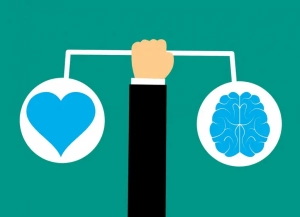Get Emotional
Think about all the nonprofits in the world and the number that you personally support.
Did you do a detailed analysis using a cost v. value matrix to make an informed, rational decision about where to donate your hard-earned money?
Unlikely. It’s much more likely that you support nonprofits with which you feel a personal, emotional connection.
Emotion is the driver, but logic does help navigate. If I asked why you support the nonprofits you do, I bet your answer would contain a kernel of logic. You’d want to know how the organizations are making investments to eradicate societal issues such as finding affordable housing for our unhoused neighbors, providing care and services for people escaping intimate partner violence, or eradicating cancer.
When it comes to money, we use logic to keep our emotions in check. We want to convince ourselves (and others) that we are being smart about our donation–we aren’t giving money away willy-nilly to just anybody who asks.
When asking someone to support a cause we love, what kind of approach will be most effective? An emotion-oriented pitch or a logical “best bang for the buck” logic-filled argument?
If your cause doesn’t activate something in your donor’s heart, chances are slim they will go down the logical path with you, even if you make a great case. Why? Because they are already going down that heartfelt path with the nonprofits with which they DO have an emotional connection.
How do we find out if that emotional connection exists between a donor and your cause? Research can determine if someone gives to similar-type organizations. The best way, however, is to just ask.
The beauty of asking, “Tell me, what nonprofits do you support and why?” is that you will get anything but a simple response. You will learn all kinds of things about why a person cares about what they do, their successes and failures, life influences, mentors, family dynamics, etc.—and whether any of that lines up with the work of your organization.
Here’s an example from my career: Why would a group of predominantly Jewish donors give more than $2 million to a private Christian college?
Because that college was establishing a chair in Holocaust Studies.
And naming it in honor of their first Jewish board member.
Who was a Holocaust survivor.
Raising that $2 million was an act of love and respect. Any kind of cost/value calculation was secondary.
At year end, The Chronicle of Philanthropy writes about the donors who made the top charitable gifts that year. I’ve yet to read a story about one of those donors that didn’t contain an intensely personal story related to the cause(s) they support.
Donors are people. Foundations are run by people. People have rich and complex emotional lives. Mining that emotional landscape for the “why” that lies beneath the surface is the most important first step in creating an honest, thoughtful bond between the donor and your organization.
Learn more about getting emotional in Chapter 2 of my new book “Finding Funding: How to Ask for Money and Get It.”

